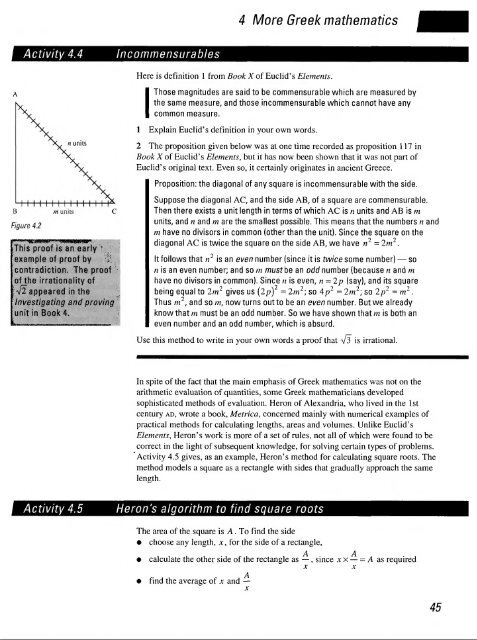history of mathematics - National STEM Centre
history of mathematics - National STEM Centre
history of mathematics - National STEM Centre
Create successful ePaper yourself
Turn your PDF publications into a flip-book with our unique Google optimized e-Paper software.
Activity 4.4<br />
n units<br />
This pro<strong>of</strong> is an early<br />
example <strong>of</strong> pro<strong>of</strong> by<br />
contradiction. The pro<strong>of</strong><br />
<strong>of</strong> the irrationality <strong>of</strong><br />
A/2 appeared in the<br />
Investigating and proving<br />
unit in Book 4.<br />
Incommensurables<br />
4 More Greek <strong>mathematics</strong><br />
Here is definition 1 from Book X <strong>of</strong> Euclid's Elements.<br />
I<br />
Those magnitudes are said to be commensurable which are measured by<br />
the same measure, and those incommensurable which cannot have any<br />
common measure.<br />
1 Explain Euclid's definition in your own words.<br />
2 The proposition given below was at one time recorded as proposition 117 in<br />
Book X <strong>of</strong> Euclid's Elements, but it has now been shown that it was not part <strong>of</strong><br />
Euclid's original text. Even so, it certainly originates in ancient Greece.<br />
Proposition: the diagonal <strong>of</strong> any square is incommensurable with the side.<br />
Suppose the diagonal AC, and the side AB, <strong>of</strong> a square are commensurable.<br />
Then there exists a unit length in terms <strong>of</strong> which AC is n units and AB is m<br />
units, and n and m are the smallest possible. This means that the numbers n and<br />
m have no divisors in common (other than the unit). Since the square on the<br />
diagonal AC is twice the square on the side AB, we have n 2 = 2m 1<br />
It follows that n 2 is an even number (since it is twice some number) so<br />
n is an even number; and so m mustbe an ode/number (because n and m<br />
have no divisors in common). Since n is even, n = 2p (say), and its square<br />
being equal to 2m 2 gives us (2p) 2 = 2m 2 ; so 4p 2 = 2m 2 ; so 2p 2 = m 2 .<br />
Thus m 2 , and so m, now turns out to be an even number. But we already<br />
know that m must be an odd number. So we have shown that m is both an<br />
even number and an odd number, which is absurd.<br />
Use this method to write in your own words a pro<strong>of</strong> that V^ is irrational.<br />
In spite <strong>of</strong> the fact that the main emphasis <strong>of</strong> Greek <strong>mathematics</strong> was not on the<br />
arithmetic evaluation <strong>of</strong> quantities, some Greek mathematicians developed<br />
sophisticated methods <strong>of</strong> evaluation. Heron <strong>of</strong> Alexandria, who lived in the 1st<br />
century AD, wrote a book, Metrica, concerned mainly with numerical examples <strong>of</strong><br />
practical methods for calculating lengths, areas and volumes. Unlike Euclid's<br />
Elements, Heron's work is more <strong>of</strong> a set <strong>of</strong> rules, not all <strong>of</strong> which were found to be<br />
correct in the light <strong>of</strong> subsequent knowledge, for solving certain types <strong>of</strong> problems.<br />
Activity 4.5 gives, as an example, Heron's method for calculating square roots. The<br />
method models a square as a rectangle with sides that gradually approach the same<br />
length.<br />
Activity 4.5 Heron's algorithm to find square roots<br />
The area <strong>of</strong> the square is A. To find the side<br />
• choose any length, x, for the side <strong>of</strong> a rectangle,<br />
A A<br />
• calculate the other side <strong>of</strong> the rectangle as —, since x x — = A as required<br />
x x<br />
A<br />
• find the average <strong>of</strong> x and — x<br />
45
















